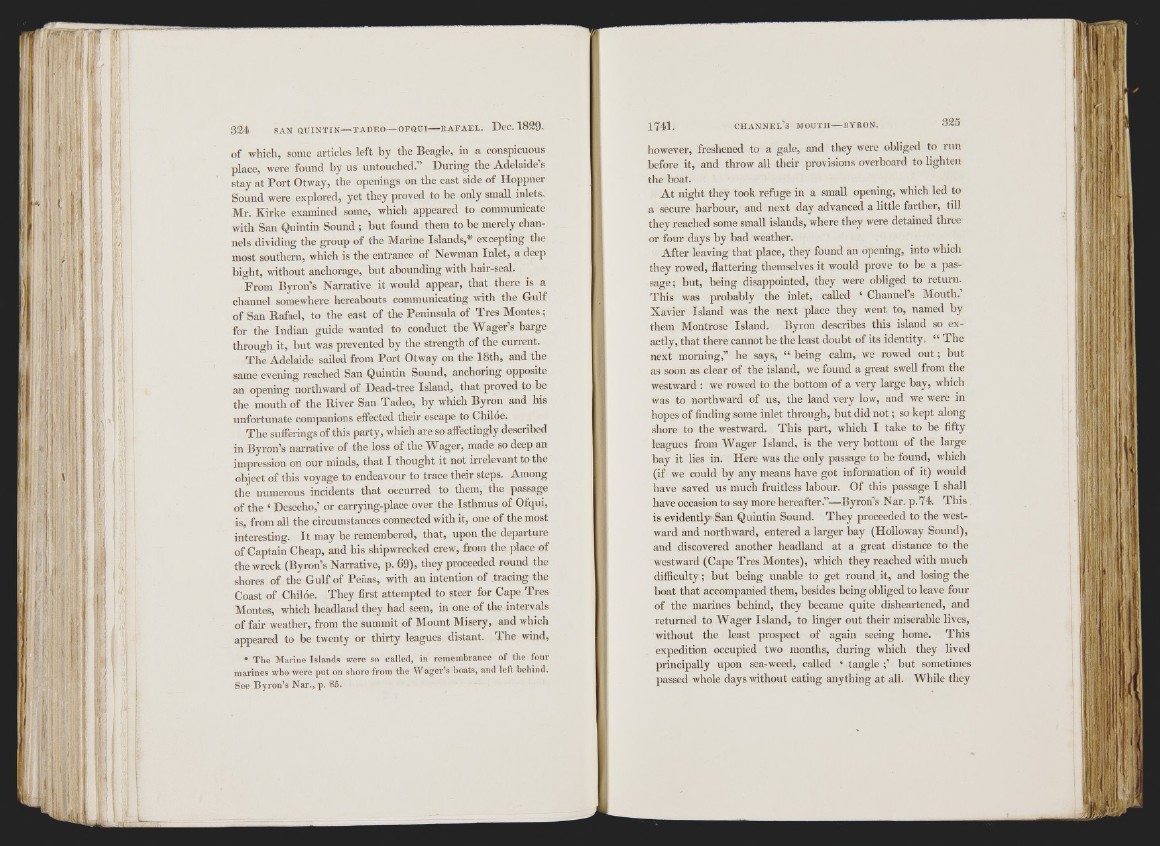
I 1
M\
of which, some articles left by the Beagle, in a conspicuous
place, were found by us untouched." During the Adelaide’s
stay at Port Otway, the openings on the east side of Hoppner
Sound were explored, yet they proved to be only small inlets.
Mr. Kirke examined some, which appeared to communicate
with San Quintin Sound ; but found them to be merely channels
dividing the group of the Marine Islands,* excepting tlie
most southern, which is the entrance of Newman Inlet, a deep
bight, without anchorage, but abounding with hair-seal.
From Byron’s Narrative it would appear, that there is a
channel somewhere hereabouts communicating wdth the Gulf
of San Rafael, to the east of the Peninsula of Tres Montes;
for the Indian guide wanted to conduct the Wager’s barge
through it, but was prevented by the strength of the current.
The Adelaide sailed from Port Otway on the 18th, and the
same evening reached San Quintin Sound, anchoring opposite
an opening northward of Dead-tree Island, that proved to be
the mouth of the River San Tadeo, by which Byron and his
unfortunate companions effected their escape to Clúlóe.
The sufferings of this party, which are so affectingly described
in Byron’s narrative of the loss of the Wager, made so deep an
impression on our minds, that I thought it not irrelevant to the
object of this voyage to endeavour to trace their steps. Among
the numerous incidents that occurred to them, the passage
of the ‘ Desecho,’ or carrying-place over the Isthmus of Ofqui,
is, from all the circumstances connected with it, one of the most
interesting. It may be remembered, that, upon the departure
of Captain Cheap, and his shipwrecked crew, from the place of
the wreck (Byron’s Narrative, p. 69), they proceeded round the
shores of the Gulf of Peñas, with an intention of tracing the
Coast of Chiloe. They first attempted to steer for Cape Tres
Montes, which headland they had seen, in one of the intervals
of fair weather, from the summit of Mount Misery, and which
appeared to be twenty or thirty leagues distant. The wind,
• T h e Marine Islands were so called, in remembrance of the four
marines who were put on shore from the W ager’s boats, and left behind.
See B y ro n ’s Nar., p. 85.
however, freshened to a gale, and they were obliged to run
before it, and throw all their provisions overboard to lighten
the boat.
At night they took refuge in a small opening, which led to
a secure harbour, and next day advanced a little farther, till
they reached some small islands, where they were detained three
or four days by bad weather.
After leaving that place, they found an opening, into which
they rowed, flattering themselves it would prove to be a passage;
but, being disappointed, they were obliged to return.
This was probably the inlet, called ‘ Channel’s Mouth.’
Xavier Island was the next place they went to, named by
them Montrose Island. Byron describes this island so exactly,
that there cannot be the least doubt of its identity. “ The
next morning,” he says, “ being calm, we rowed ou t; but
as soon as clear of the island, we found a great swell from the
westward : we rowed to the bottom of a very large bay, which
was to northward of us, the land very low, and we were in
hopes of finding some inlet through, but did not; so kept along
shore to the westward. This part, which I take to be fifty
leagues from Wager Island, is the very bottom of the large
bay it lies in. Here was the only passage to be found, which
(if we could by any means have got information of it) would
liave saved us much fruitless labour. Of this passage I shall
have occasion to say more hereafter,”—Byron’s N ar. p. 74. This
is evidently San Quintin Sound. They proceeded to the westward
and northward, entered a larger bay (Holloway Sound),
and discovered another headland at a great distance to the
westward (Cape Tres Montes), which they reached with much
difficulty; but being unable to get round it, and losing the
boat that accompanied them, besides being obliged to leave four
of the marines behind, they became quite disheartened, and
returned to Wager Island, to linger out their miserable lives,
without the least prospect of again seeing home. This
expedition occupied two months, during which they lived
principally upon sea-weed, called ‘ tangle ;’ but sometimes
passed whole days without eating anything at all. While they
ii;